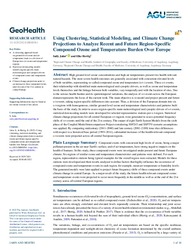Using Clustering, Statistical Modeling, and Climate Change Projections to Analyze Recent and Future Region‐Specific Compound Ozone and Temperature Burden Over Europe
DOI: https://doi.org/10.1029/2021GH000561
Persistent URL: http://resolver.sub.uni-goettingen.de/purl?gldocs-11858/9986
Persistent URL: http://resolver.sub.uni-goettingen.de/purl?gldocs-11858/9986
Jahn, Sally; Hertig, Elke, 2022: Using Clustering, Statistical Modeling, and Climate Change Projections to Analyze Recent and Future Region‐Specific Compound Ozone and Temperature Burden Over Europe. In: GeoHealth, Band 6, 4, DOI: 10.1029/2021GH000561.
 |
Dokument öffnen: |
High ground‐level ozone concentrations and high air temperatures present two health‐relevant natural hazards. The most severe health outcomes are generally associated with concurrent elevated levels of both variables, representing so‐called compound ozone and temperature (o‐t‐) events. These o‐t‐events, their relationship with identified main meteorological and synoptic drivers, as well as ozone and temperature levels themselves and the linkage between both variables, vary temporally and with the location of sites. Due to the serious health burden and its spatiotemporal variations, the analysis of o‐t‐events across the European domain represents the focus of the current work. The main objective is to model and project present and future o‐t‐events, taking region‐specific differences into account. Thus, a division of the European domain into six o‐t‐regions with homogeneous, similar ground‐level ozone and temperature characteristics and patterns built the basis of the study. In order to assess region‐specific main meteorological and synoptic drivers of o‐t‐events, statistical downscaling models were developed for selected representative stations per o‐t‐region. Statistical climate change projections for all central European o‐t‐regions were generated to assess potential frequency shifts of o‐t‐events until the end of the 21st century. The output of eight Earth System Models from the sixth phase of the Coupled Model Intercomparison Project considering SSP245 and SSP370 scenario assumptions was applied. By comparing midcentury (2041–2060) and late century (2081–2100) time slice differences with respect to a historical base period (1995–2014), substantial increases of the health‐relevant compound o‐t‐events were projected across all central European regions. Plain Language Summary:
Compound events with concurrent high levels of ozone, being a major pollutant present in the air near Earth's surface, and of air temperature, have strong negative impacts on the health of humans. In this study, these compound events were investigated under present and future European climate. Six regions of similar ozone and temperature characteristics and patterns were defined. For each region, representative stations being typical examples for the overall region were extracted. Models for these stations were developed and their results analyzed to define factors that highly influence the occurrence of compound ozone and temperature events in each region, for example, mean air temperature or humidity levels. The generated models were later applied to project future frequency shifts of these compound events under climate change in central Europe. As a major result of the study, the future health‐relevant compound ozone and temperature events were projected to occur more frequently in the middle as well as at the end of the 21st century across all central European regions. Key Points:
A clustering approach based on ground‐level ozone and air temperature leads to a division of Europe into six ozone and temperature regions.
Statistical downscaling models identify region‐specific main meteorological and synoptic drivers of compound ozone and temperature events.
Climate change projections point to an increase in these compound events until the end of the 21st century in central Europe.
Statistik:
ZugriffsstatistikSammlung:
Schlagworte:
air pollutionair temperature
climate change
compound events
spatial clustering
statistical downscaling
This is an open access article under the terms of the Creative Commons Attribution License, which permits use, distribution and reproduction in any medium, provided the original work is properly cited.

